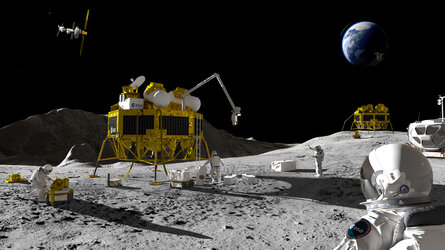Accept all cookies Accept only essential cookies See our Cookie Notice

About ESA
The European Space Agency (ESA) is Europe’s gateway to space. Its mission is to shape the development of Europe’s space capability and ensure that investment in space continues to deliver benefits to the citizens of Europe and the world.
Highlights
ESA - United space in Europe
This is ESA ESA facts Member States & Cooperating States Funding Director General Top management For Member State Delegations European vision European Space Policy ESA & EU Space Councils Responsibility & Sustainability Annual Report Calendar of meetings Corporate newsEstablishments & sites
ESA Headquarters ESA ESTEC ESA ESOC ESA ESRIN ESA EAC ESA ESAC Europe's Spaceport ESA ESEC ESA ECSAT Brussels Office Washington OfficeWorking with ESA
Business with ESA ESA Commercialisation Gateway Law at ESA Careers Cyber resilience at ESA IT at ESA Newsroom Partnerships Merchandising Licence Education Open Space Innovation Platform Integrity and Reporting Administrative Tribunal Health and SafetyMore about ESA
History ESA Historical Archives Exhibitions Publications Art & Culture ESA Merchandise Kids Diversity ESA Brand CentreLatest
Space in Member States
Find out more about space activities in our 23 Member States, and understand how ESA works together with their national agencies, institutions and organisations.
Science & Exploration
Exploring our Solar System and unlocking the secrets of the Universe
Go to topicAstronauts
Missions
Juice Euclid Webb Solar Orbiter BepiColombo Gaia ExoMars Cheops Exoplanet missions More missionsActivities
International Space Station Orion service module Gateway Concordia Caves & Pangaea BenefitsLatest
Space Safety
Protecting life and infrastructure on Earth and in orbit
Go to topicAsteroids
Asteroids and Planetary Defence Asteroid danger explained Flyeye telescope: asteroid detection Hera mission: asteroid deflection Near-Earth Object Coordination CentreSpace junk
About space debris Space debris by the numbers Space Environment Report In space refuelling, refurbishing and removingSafety from space
Clean Space ecodesign Zero Debris Technologies Space for Earth Supporting Sustainable DevelopmentLatest
Applications
Using space to benefit citizens and meet future challenges on Earth
Go to topicObserving the Earth
Observing the Earth Future EO Copernicus Meteorology Space for our climate Satellite missionsCommercialisation
ESA Commercialisation Gateway Open Space Innovation Platform Business Incubation ESA Space SolutionsLatest
Enabling & Support
Making space accessible and developing the technologies for the future
Go to topicBuilding missions
Space Engineering and Technology Test centre Laboratories Concurrent Design Facility Preparing for the future Shaping the Future Discovery and Preparation Advanced Concepts TeamSpace transportation
Space Transportation Ariane Vega Space Rider Future space transportation Boost! Europe's Spaceport Launches from Europe's Spaceport from 2012Latest

An X-ray view of the COSMOS field
Thank you for liking
You have already liked this page, you can only like it once!
When we gaze up at the night sky, we are only seeing part of the story. Unfortunately, some of the most powerful and energetic events in the Universe are invisible to our eyes – and to even the best optical telescopes.
Luckily, these events are not lost; they appear vividly in the high-energy sky, making them visible to space-based telescopes like ESA's XMM-Newton, which observes the Universe in the X-ray part of the spectrum.
This image shows a patch of sky from the COSMOS survey, as viewed by XMM-Newton. COSMOS is a project studying how galaxies form and evolve, gathering observations using a variety of ground- and space-based telescopes. This image alone features about two thousand supermassive black holes, and over a hundred clusters of galaxies.
Small point sources dotted across the frame show supermassive black holes that are hungrily devouring matter from their surroundings. All massive galaxies host a black hole at their core, but not all of these are actively accreting, dragging in surrounding matter and releasing high-energy radiation and powerful jets in the process. As they are so energetic, one of the best ways to hunt these extreme bodies is by using X-ray telescopes.
The larger blobs in this image, mainly red and yellow, reveal another class of cosmic behemoths: galaxy clusters. Containing up to several thousand galaxies, galaxy clusters are the largest cosmic structures to be held together by gravity. The galaxies within these clusters are enveloped by hot gas, which releases a diffuse X-ray glow that can be detected by telescopes like XMM-Newton.
The image combines data collected by the EPIC instrument on board XMM-Newton at energies from 0.5 to 2 keV (shown in red), 2 to 4.5 keV (shown in green) and 4.5 to 10 keV (shown in blue). The observations were taken between 2003 and 2005, and the image spans 1.4 degrees on each side, corresponding to almost three times the diameter of the full Moon.
This image was first published in the paper “The XMM-Newton Wide-Field Survey in the COSMOS Field. I. Survey Description” by G. Hasinger et al. in 2007.
-
CREDIT
ESA/XMM-Newton/Gunther Hasinger, Nico Cappelluti, and the XMM-COSMOS collaboration. -
LICENCE
ESA Standard Licence

X-ray serendipity

Happy Birthday XMM-Newton

XMM-Newton's view of galaxy cluster Abell 1689

XMM 10 years














 Germany
Germany
 Austria
Austria
 Belgium
Belgium
 Denmark
Denmark
 Spain
Spain
 Estonia
Estonia
 Finland
Finland
 France
France
 Greece
Greece
 Hungary
Hungary
 Ireland
Ireland
 Italy
Italy
 Luxembourg
Luxembourg
 Norway
Norway
 The Netherlands
The Netherlands
 Poland
Poland
 Portugal
Portugal
 Czechia
Czechia
 Romania
Romania
 United Kingdom
United Kingdom
 Slovenia
Slovenia
 Sweden
Sweden
 Switzerland
Switzerland

























